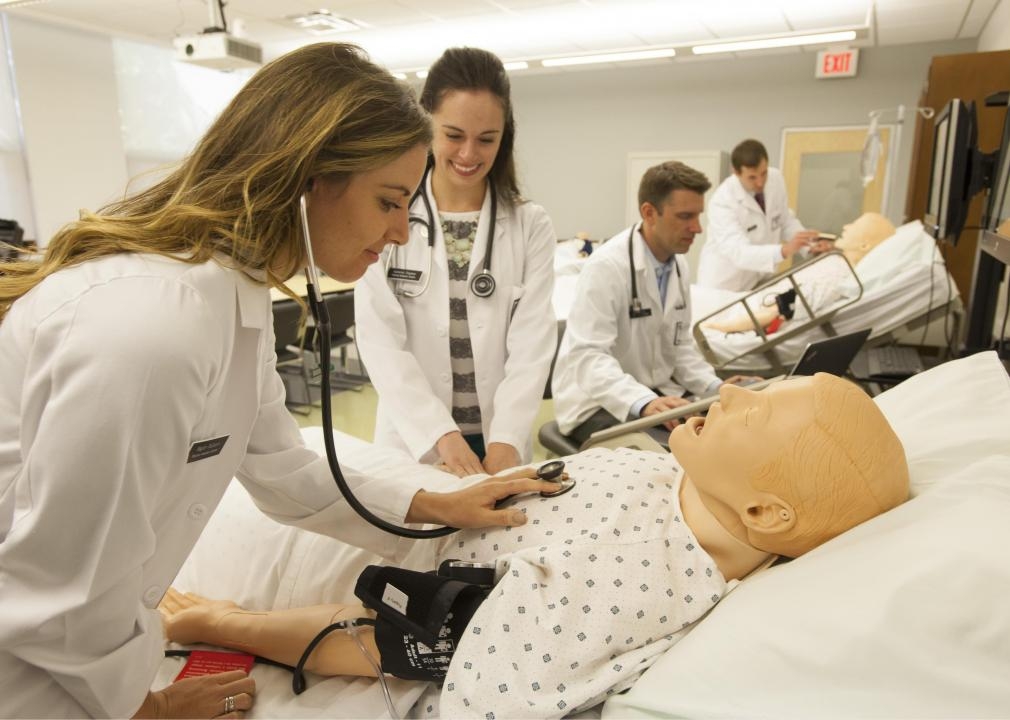100 Highest-Paying Jobs & Careers in the U.S of All Time
 |
| Higest paying jobs in America. Photo: KnowInsiders.com |
| Contents |
Highest salaries can be found in the healthcare industry, which also has a promising future in the United States. Despite the fact that many people prioritize financially rewarding work when looking for a new position or career, this is not the case for everyone. Those who place a premium on financial security should review our ranking of the best paying occupations.
There are many things to think about when deciding on a career path. Your ideal career path will be one that fits in with who you are and what you've accomplished so far.
Top 10 Highest-Paying Jobs in America of All Time
1. Anesthesiologists: $271,440
 |
| Anesthesiologists - Photo: Stacker |
According to the BLS, anesthesiologists are doctors who "administer anesthetics and analgesics for pain management prior to, during, and after surgery." This extremely niche field of work has been ranked as the highest paying job in the world.
An anesthesiologist's schedule is long and erratic because it depends on the needs of the operating room. This is due to the fact that anesthesiologists are required for both planned surgeries and unplanned ones, such as those necessitated by trauma or the birthing process.
Anesthesiologists in the United States typically complete a four-year residency in anesthesiology, and possibly more depending on the subspecialty, after completing four years of medical school.
Job Prospects — The Bureau of Labor Statistics predicts a nationwide employment decline of 1% over the next decade.
2. Surgeons: $251,650
 |
| Surgeons - Photo: OwlGuru |
Surgeons earn the most money despite the high stakes of their work. Surgeons have a high earning potential because their profession is high-risk and requires a great deal of knowledge and training.
Surgeons have one of the highest salaries, despite having to spend years in school to become experts in their field. Depending on the nature of the surgery they practice, surgeons may be required to work long, unpredictable shifts. Surgeons in fields like trauma or neurosurgery often work extended, even overnight shifts, while those who specialize in preventative and elective surgeries may have a more regular schedule.
Surgeons fix broken bones and operate on patients with serious illnesses like cancer. Surgeons aid in the coordination of pre- and post-operative care. Surgeons often take calls from worried patients outside of normal business hours, and those who are on call may be required to make unscheduled visits to the hospital.
* Academics Having completed medical school, a lengthy residency program, and often a specialized fellowship, a surgeon has accomplished a great deal.
The Bureau of Labor Statistics predicts a 3% increase in total employment within the next decade.
3. Obstetricians-Gynecologists: $239,120
 |
| Obstetricians-Gynecologists - Photo: Worldwide Tweets |
OB-GYNs, who are medical doctors who focus on women's reproductive systems and deliver babies, earn a salary that is just slightly higher than that of orthodontists and oral and maxillofacial surgeons combined.
To help their patients and their babies, the best OB-GYNs are excellent communicators. They are also great under pressure, especially during labor, which can happen at any time of day or night.
Education — Becoming an OB-GYN requires four years of study beyond medical school, including an obstetrics fellowship and a gynecology residency. After that, these doctors need to pass a licensing exam before they can start seeing patients.
Job Prospects — The BLS predicts a 2% drop in OB/GYN employment by the year 2030.
 10 Highest Paying Jobs in the World: Cardiologist vs Anesthesiologist 10 Highest Paying Jobs in the World: Cardiologist vs Anesthesiologist Are you curious about the highest-salary jobs in the world? Which requirements are needed to pursue these careers? |
4. Orthodontists: $237,990
 |
| Photo: Sierra Dental & Orthodontics |
Dentists frequently refer patients to orthodontists, who are experts in dental correction. X-rays, braces, custom mouth guards, and other procedures are commonplace for these doctors to perform.
Successful orthodontists need strong communication skills for interacting with patients, as well as analytical and problem-solving prowess for diagnosing and correcting orthodontic issues. Many orthodontists are employed by larger clinics, but a select few manage their own practices successfully.
After obtaining a bachelor's degree, aspiring orthodontists must enroll in and graduate from a dental school program that includes both classroom and clinical instruction. They then have to take the licensing exam and finish their residency training.
The BLS predicts that there will be 6,900 orthodontic jobs in the United States by 2030, an increase of 8% from 2020.
5. Oral and Maxillofacial Surgeons: $234,990
 |
| Photo: Careers in Healthcare |
Many conditions affecting the face and jaw are addressed by oral and maxillofacial surgeons. Problematic wisdom teeth, crooked jaws, oral tumors, and cysts are just some of the more common issues they may have to deal with. Dental implant surgery is another service they might offer.
An undergraduate degree, four years of dental school, and at least four years of residency are the norm for entry into the field of oral and maxillofacial surgery. Surgeons in the United States typically take a two-part exam administered by the American Board of Oral and Maxillofacial Surgery after completing their training.
Job Outlook — From 2020 to 2030, employment is expected to increase 8%, according to the BLS
6. Physicians (Other): $218,850
 |
| Physicians - Photo: Nightingale College |
When compared to the median income of all doctors, regardless of specialty, they would be sixth highest. Specialists in the fields of allergy, cardiology, dermatology, oncology (cancer treatment), gastroenterology (the digestive system), and ophthalmology (the eyes) are all included in this "other" category. It also includes radiologists, who examine x-rays and treat cancer patients with radiation, and pathologists, who examine tissue samples for abnormalities.
Doctors of medicine (M.D.) and osteopathic medicine (D.O.) must complete four years of medical school in addition to a four-year undergraduate degree. The majority of clinical fields also necessitate completion of a residency program, with some professionals going on to pursue additional fellowship education afterward.
The BLS predicts a five percent increase in the number of physicians employed in the United States by the year 2029.
7. Psychiatrists: $217,100
 |
| Psychiatrists - Photo: Medical News Today |
There is a wide range of subspecialties within the field of psychiatry, even though all psychiatrists help treat mental health problems.
Forensic (legal) psychiatry, addiction psychiatry, and consultation (medical) psychiatry are just a few of the subspecialties within the field of psychiatry. Some psychiatrists opt to focus on psychoanalysis, in which they aid the patient in reflecting on and processing significant life experiences and emotional reactions.
Psychiatrists can be found in a wide variety of settings, including private practice, hospitals, community organizations, schools, rehabilitation centers, and even correctional facilities.
In terms of training, psychiatrists are medical doctors as opposed to psychologists. A four-year undergraduate degree is required, followed by three years of medical school and a residency. The American Psychiatric Association states that psychiatry residencies consist of four years total, with the first year spent working in a hospital and managing a wide range of medical conditions. Graduates then frequently submit an application to the American Board of Psychiatry and Neurology for board certification.
Job Prospects — Over the next few years, psychologists are predicted to have one of the highest rates of growth among medical specialists. From 2020 to 2030, the BLS anticipates a 13% increase in employment.
8. Prosthodontists: $214,870
 |
| Prosthodontists - Photo: OwlGuru |
Dentists specializing in prosthodontics use prosthetics like dental implants, dentures, bridges, crowns, and veneers to restore patients' smiles after tooth loss or damage. Doctors who do well in this field have a natural curiosity for science, a keen eye for diagnosing dental issues, and an understanding of how to treat them mechanically. The needs of surgical patients and those undergoing radiation or chemotherapy must be understood because many of them work with cancer patients.
To become a prosthodontist, one must first earn a dental degree (DDS or DMD) from an accredited dental school. This requires four years of study beyond undergraduate education. Candidates then enroll in a residency program and submit an application to the American Board of Prosthodontics for board certification.
Job Prospects * — In the United States, there are only about 700 prosthodontists, making it a small but select group. However, the BLS predicts that the number of prosthodontists will increase by 8% within the next decade.
9. Family Medicine Physicians: $214,370
 |
| Family Medicine Physicians - Photo: Stacker |
According to the BLS, these doctors "diagnose, treat, and provide preventive care for individuals, couples, and families across the lifespan." When patients need more advanced care, these primary care physicians frequently refer them to specialists.
Primary care physicians, or family medicine doctors, see patients on a routine basis and treat a wide range of conditions, from acute issues like colds and flu to long-term problems like diabetes, asthma, and heart disease.
Primary care physicians can specialize in either adult patients (internists) or pediatric patients (pediatricians). Family doctors are medical professionals who treat people of all ages, from newborns to the elderly. Family physicians treat a wide variety of illnesses and injuries due to the diversity of their patient base.
In order to become a family medicine doctor, one must first graduate from medical school and then complete a residency program. Before applying for board certification, doctors must have worked in each specialty for a minimum number of months.
Employment Prospects: The BLS projects a 5% increase in demand for family physicians between 2020 and 2030.
10. Internal Medicine Physicians: $210,960
 |
| Internal Medicine Physicians - Photo: Stacker |
Another position in the medical field comes in at number 10. Specialists in the treatment of adults, internists may work as either primary care physicians or hospitalists. Internal medicine specialists who also work in primary care settings see a wide variety of patients and treat conditions as varied as asthma, diabetes, high cholesterol, and hypertension. Visits typically last no more than 30 minutes, so the ability to make snap judgments is crucial.
Training — After finishing college and medical school, internists usually participate in a residency program in which they gain experience in a variety of medical fields. Some doctors choose to further their education by specializing in cardiology, pulmonology, or oncology. Board-certified internists are more competitive for jobs than their non-certified peers.
Job Prospects — The BLS predicts a 1% decline in demand for internists specializing in general medicine by the year 2030.
Top 100 Highest-Paying Jobs in the U.S 2021/2022
(Ranked by Indeed)
1. Cardiologist
National average salary: $351,827 per year
2. Anesthesiologist
National average salary: $326,296 per year
3. Orthodontist
National average salary: $264,850 per year
4. Psychiatrist
National average salary: $224,577 per year
5. Surgeon
National average salary: $216,248 per year
6. Periodontist
National average salary: $214,896 per year
7. Physician
National average salary: $202,387 per year
8. Dentist
National average salary: $196,417 per year
9. Internal medicine physician
National average salary: $194,938 per year
10. Obstetrician
National average salary: $191,931 per year
11. Nurse anesthetist
National average salary: $185,856 per year
12. Pediatrician
National average salary: $180,202 per year
13. General practitioner
National average salary: $170,283 per year
14. Enterprise architecture manager
National average salary: $168,762 per year
15. Quantitative analyst
National average salary: $153,539 per year
16. Vice president
National average salary: $151,358 per year
17. Director of information security
National average salary: $149,204 per year
18. Enterprise architect
National average salary: $142,355 per year
19. Software architect
National average salary: $139,127 per year
20. Software engineering manager
National average salary: $138,933 per year
21. Senior clinical pharmacist
National average salary: $136,971 per year
22. Data warehouse architect
National average salary: $134,999 per year
23. Site reliability engineer
National average salary: $134,840 per year
24. Chief marketing officer
National average salary: $133,440 per year
25. Cloud engineer
National average salary: $123,688 per year
26. Chief information officer
National average salary: $123,155 per year
27. Data scientist
National average salary: $121,673 per year
28. Optometrist
National average salary: $118,486 per year
29. Solutions engineer
National average salary: $114,155 per year
30. Chief executive officer
National average salary: $112,591 per year
31. Pharmacy manager
National average salary: $112,546 per year
32. Corporate controller
National average salary: $112,203 per year
33. Podiatrist
National average salary: $112,181 per year
34. Full stack developer
National average salary: $111,846 per year
35. Associate general counsel
National Average Salary: $110,733 per year
36. Financial planning and analysis manager
National average salary: $110,418 per year
37. Nurse practitioner
National average salary: $110,164 per year
38. Corporate counsel
National average salary: $109,691 per year
39. Analytics manager
National Average Salary: $108,565 per year
40. Actuary
National average salary: $108,313 per year
41. Software engineer
National average salary: $106,119 per year
42. Physician assistant
National average salary: $105,594 per year
43. Plant manager
National average salary: $104,902 per year
44. System engineer
National average salary: $104,213 per year
45. Midwife
National average salary: $103,311 per year
46. Java developer
National average salary: $103,292 per year
47. Financial reporting manager
National average salary: $102,178 per year
48. Mathematician
National average salary: $100,351 per year
49. Economist
National average salary: $98,716 per year
50. Aeronautical engineer
National average salary: $98,396 per year
51. Veterinarian
National average salary: $95,762 per year
52. Senior scientist
National average salary: $95,203 per year
53. Director of operations
National average salary: $95,007 per year
54. Database administrator
National average salary: $92,298 per year
55. Nuclear engineer
National average salary: $91,119 per year
56. User experience designer
National average salary: $89,915 per year
57. IT manager
National average salary: $89,577 per year
58. Attorney
National average salary: $89,487 per year
59. Political affairs officer
National average salary: $89,085 per year
60. Environmental health and safety officer
National average salary: $88,684 per year
61. Construction superintendent
National average salary: $87,285 per year
62. Psychologist
National average salary: $86,181 per year
63. Application developer
National average salary: $86,120 per year
64. Systems administrator
National average salary: $86,059 per year
65. Engineer
National average salary:: $85,621 per year
66. Statistician
National average salary: $84,336 per year
67. Judge
National average salary: $83,715 per year
68. Director of marketing
National average salary: $83,656 per year
69. Mechanical engineer
National average salary: $83,230 per year
70. Information security analyst
National average salary: $83,001 per year
71. Research scientist
National average salary: $82,927 per year
72. Clinical director
National average salary: $82,422 per year
73. Senior MRI technologist
National average salary: $82,111 per year
74. Associate professor
National average salary: $81,957 per year
75. Senior physical therapist
National average salary:: $81,715 per year
76. Civil engineer
National average salary: $81,425 per year
77. Loan officer
National average salary: $81,223 per year
78. Project manager
National average salary: $81,214 per year
79. Senior radiation therapist
National average salary: $80,891 per year
80. Occupational therapist
National average salary: $80,424 per year
81. Marine engineer
National average salary: $79,531 per year
82. Systems analyst
National average salary: $78,974 per year
83. Management analyst
National average salary: $78,300 per year
84. Construction manager
National average salary: $77,190 per year
85. Biomedical engineer
National average salary: $75,564 per year
86. Sales manager
National average salary: $75,263 per year
87. Director of public relations
National average salary: $74,798 per year
88. Industrial engineer
National average salary: $73,905 per year
89. Environmental manager
National average salary: $73,829 per year
90. Speech pathologist
National average salary: $73,248 per year
91. Cost estimator
National average salary:: $72,751 per year
92. Purchasing manager
National average salary: $72,633 per year
93. Certified public accountant
National average salary: $72,414 per year
94. Registered nurse case manager
National average salary: $69,055 per year
95. Broker
National Average Salary: $68,341 per year
96. Laboratory manager
National average salary: $66,687 per year
97. School psychologist
National average salary: $66,643 per year
98. Market researcher
National average salary: $65,349 per year
99. Chiropractor
National average salary: $65,201 per year
100. Marketing manager
National average salary: $64,259 per year
 Top 15 Highest-Paying Federal Government Jobs In the U.S Top 15 Highest-Paying Federal Government Jobs In the U.S There are executive, legislative, and judicial jobs available at the federal level. Being a politician, working for a politician, or working in the military are ... |
 Top 30 Highest-Paying Jobs in Texas Without a College Degree Top 30 Highest-Paying Jobs in Texas Without a College Degree Having a degree increases your chances of landing a good job, but it's still possible to find work without one. Below is a list of ... |
 Top 15 Companies in U.S with the Highest-Paying Jobs Today Top 15 Companies in U.S with the Highest-Paying Jobs Today It is not easy to find work in the United States, and it is even more challenging to find work that pays well. These top-tier ... |
 Top 10 Highest-Paying Jobs in the World: Cardiologist vs Anesthesiologist Top 10 Highest-Paying Jobs in the World: Cardiologist vs Anesthesiologist Are you curious about the highest-salary jobs in the world? Which requirements are needed to pursue these careers? |

























